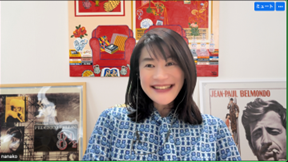Making child-rearing for children with developmental characteristics easier and more commonplace. What kind of society does the social networking service “TETETCO” aim to create?
6/24/25
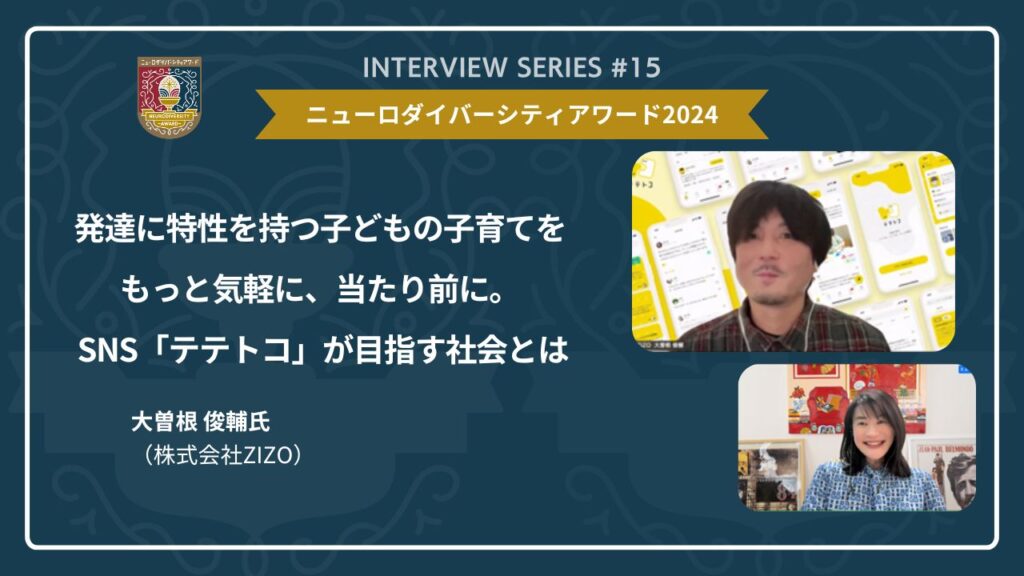
The B Lab ispleased to present the first annual Neurodiversity Awards to recognize technology, products, and social actions that have made significant contributions to the realization of a neurodiverse society, with the aim of furthering understanding of neurodiversity and paving new paths to promote diversity and inclusiveness in society. Thefirstannual Neurodiversity Awards were held to recognize technologies, products, and social actions that have made outstanding achievements toward the realization of a neuro-diverse society .The winner of the Neurodiversity Award in the social implementation category wasZIZOCorporation.B LabDirectorNanakoIshido (▲Picture9▲)spoke withthe company’sMr. ShunsukeOhsone (▲Picture1▲)about the development background, user feedback, and future initiatives for theaward-winning “Teteteco,” aSNS thatconnects with children based on their developmental characteristics.
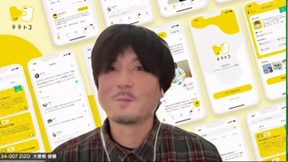
Connecting parents of children with developmental characteristics
and make everyday parenting a little more positive.
Ishido: Today we are talking with Mr. Shunsuke Ohsone of ZIZO Corporation, developer of “Tetetoco,” which won the Neurodiversity Award in the Social Implementation category of the first Neurodiversity Awards. What is “Tetetoco,” a social networking service that connects people based on their children’s developmental characteristics? Please tell us.
Mr.Ohsone :“ Teteco” is an application that can be used on iOS and Android. We, ZIZO Corporation, which developed it, are a creative agency that handles web design, website development and planning, and web promotion. Why did ZIZO develop “ Tetetoco”? First of all, let me tell you why.
In recent years, as reported in the news, the number of families requiring developmental support for their children has increased. In conjunction with this increase, the number of parents of children with developmental characteristics is also on the rise. TETETCO is a service for these parents .
Parents raising children with developmental characteristics tend to gradually narrow their friendships by refraining from socializing with so-called “dad friends” and “mom friends,” and even when they do connect with others in the same position, there are few opportunities for parents to interact with each other in depth.
Tetetoco was created with the idea of preventing the isolation of such parents, and although it is a social networking service, the most important feature that sets it apart from other social networking services is that it is only open to those who are involved. The main difference between “ Tetetoco” and other social networking services is that only those who are involved with the service can use it. (▲Photo 2▲)
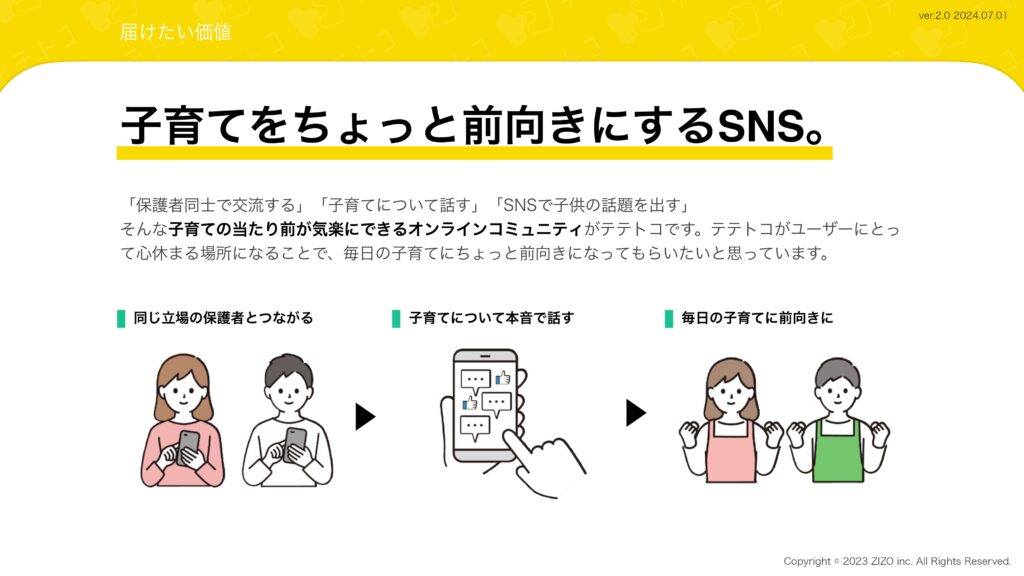
By tweeting casually and honestly
It is easy to gather many sympathetic voices.
Mr.Ohsone : Our goal is to create a society and a world where people can “talk about child development more easily and naturally. Our goal is to create a society and a world where people can “talk about child development more easily and naturally” (Photo 3). (Photo 3)
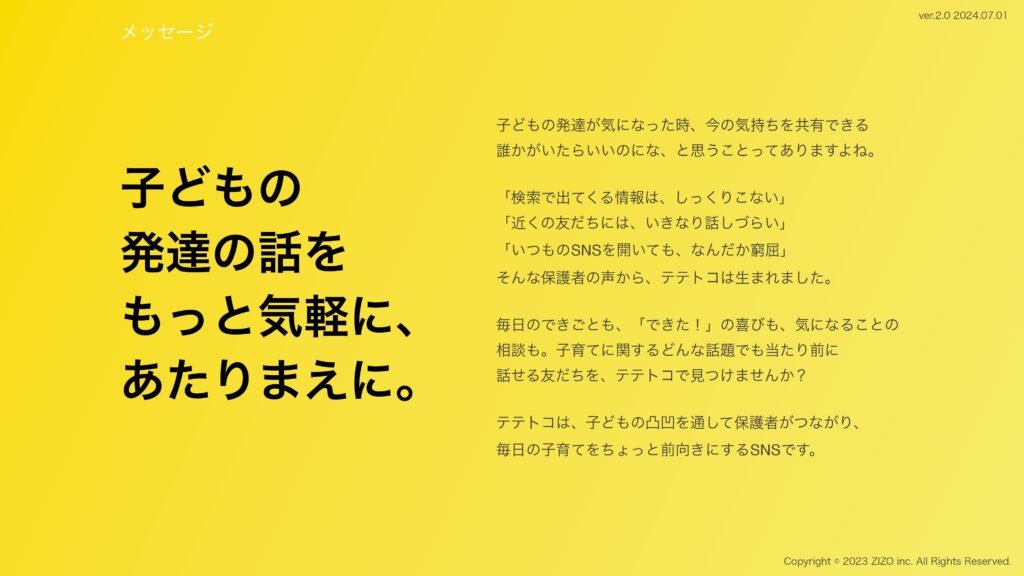
The first step in using “ Tetetoco” is to have users register their “UCHINOCO Card. In addition to age, school and preschool attendance, users are asked to register the type and frequency of attendance at child development support centers, etc., and if the child has been diagnosed by a physician, the nature of the diagnosis. (Photo 4)
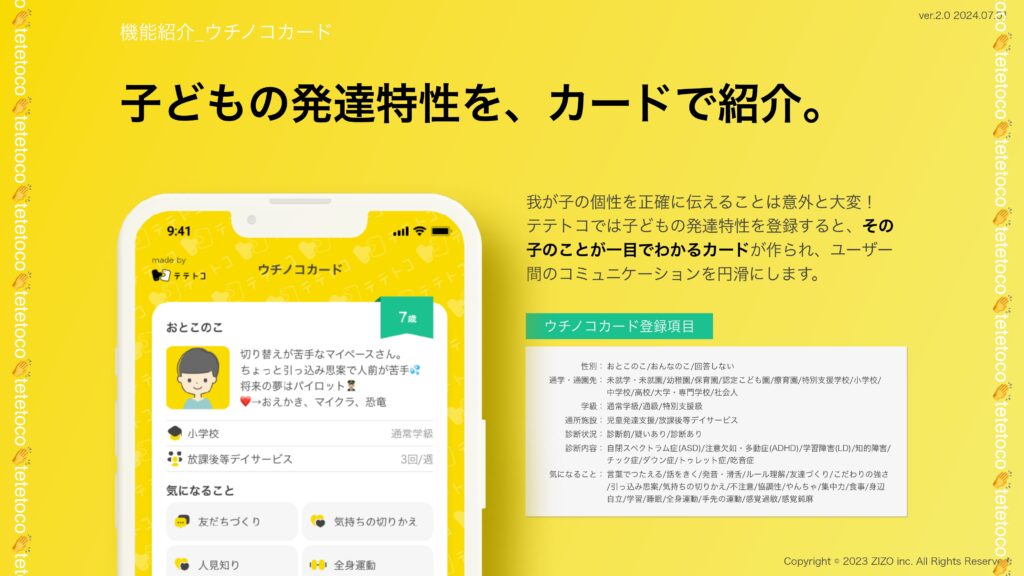
In addition to these, we ask them to register their concerns. For example, we ask them to choose about four areas of concern, such as “difficulty in communicating with words,” pronunciation, smoothness of tongue, inattentiveness, and coordination, and register them. By making the child’s characteristics visible at a glance, we make it easy for users to feel that their child may be similar to ours and to match them with other parents in the same position. Because they are in a similar position, the types of problems they face and the frequency with which they occur are naturally similar. We hope to make it easier for them to empathize with each other on a variety of issues. In this way, we believe that the characteristic of “ Tetetoco” is that people can tweet casually and honestly, and many sympathetic voices will be gathered. (▲Photo 5▲)
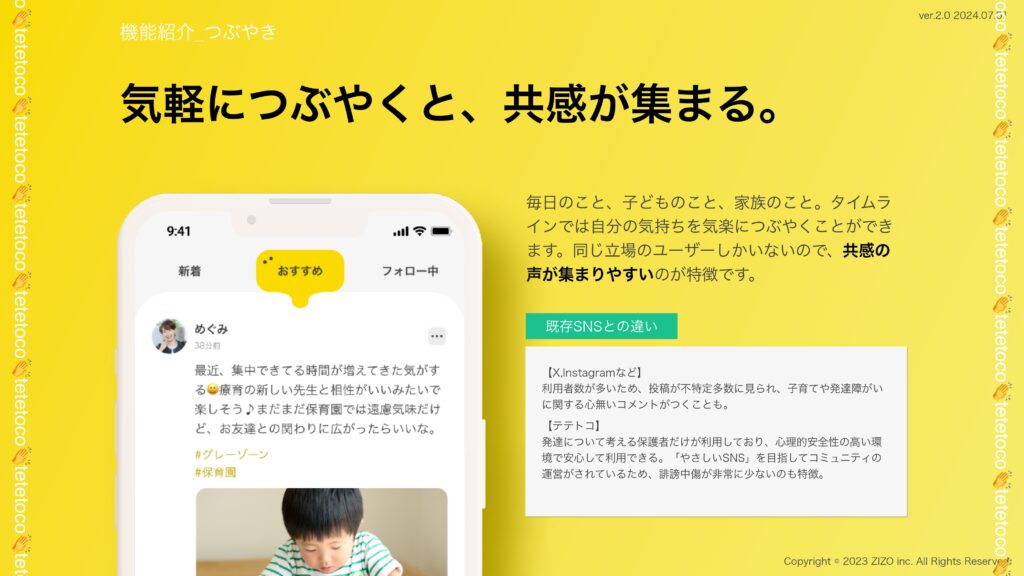
The system also provides a feature called “Talk Rooms”. This function allows users to create a talk room when they want to talk in depth about a specific theme, and allows them to gather around a common theme to discuss and share their concerns in depth. (Photo 6)
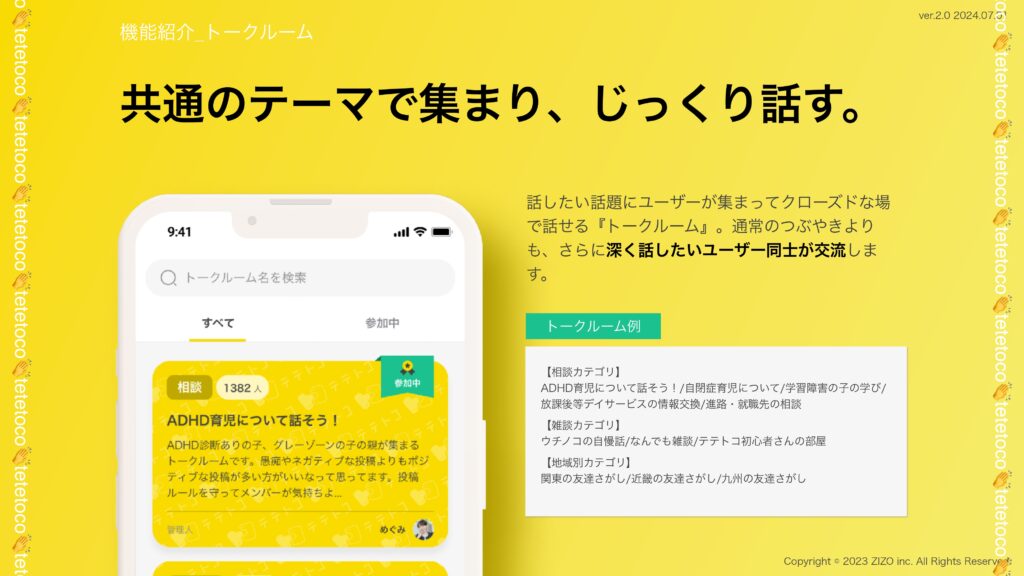
Currently, it is a social networking service for parents only, but we hope to work together with supporters, companies, and organizations in the future. Ultimately, I hope that “Tetetoco” will become a common language among parents raising children, and that it will naturally appear in the daily conversations of the child-rearing generation. (Photo 7)

Tetetco was started as a place for parents of children with developmental characteristics to communicate
TETETCO was started as a place where parents of children with developmental characteristics can communicate with each other.
Ishido: The name “ Tetetoco “ itself is very cute.
Mr.Ohsone :Written in kanji characters, “tete” is the plural form of “hand,” “to” means & (and), and “ko” is the child of a child, “tete & ko. I named it “TETETCO” to express the image of many guardians holding hands and a child in the middle of them.
Ishido: The design of the two convex and concave shapes (Photo 8) is also very nice, and I thought it was a stylish and cute service that could only come from a company that develops web design.
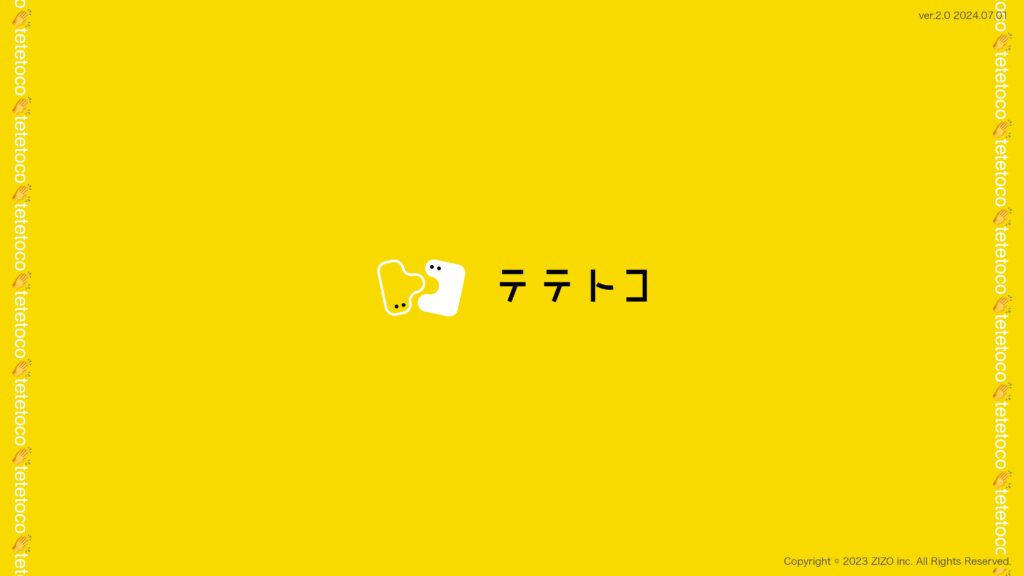
Mr.Ohsone : The logo and the application itself are also designed by in-house designers.
Ishido: This SNS is actually a service that caters to parents who are facing various difficulties. When designing this service, did you interview the people involved and the families who are supporting them?
Mr.Ohsone :To begin with how I came up with the idea for this service, one of the first things I noticed was that there were parents around me who were isolated and troubled, and that there were also people around me in my company who were suffering from such problems. From there, I talked to various people involved in the situation, and through research on social networking sites and the Internet, I found that “there are many parents who are troubled,” and “ TETETCO” was started.
Ishido: What were the most common requests you heard from people who were having problems, and what kind of functions did they want?
Mr.Ohsone : I have heard many parents say that even if they talk to their friends about the problems and worries they are having, “they don’t understand” or “it’s hard for them to understand.
Parents and families with children with developmental characteristics and parents and families with children with typical developmental characteristics still have different problems and difficulties in raising their children. Not only that, but there are very few opportunities for parents with developmentally-typical children, in other words, for the two parties involved, to interact. For example, when a child is diagnosed with a developmental trait at a daycare center’s 3-year-old child health checkup, the child may be sent to a developmental support center. Recently, however, many centers provide transportation to and from these centers, so parents who send their children to developmental support centers have fewer opportunities to meet each other, and some parents say they have not had much interaction with other parents. Therefore, we thought it would be better if there were more opportunities for the parties concerned to communicate with each other, and we thought it would be better to have such a place.
Ishido: So you have set up a place where people with the same problems can communicate with each other. So, in “ TETETCO,” you asked people to write about their problems at the beginning. At that point, there was a place to write down the results of the diagnosis. Was there any hesitation in stating the results of the diagnosis? Or were there more people who wanted to communicate openly about the diagnosis they were receiving?
Mr.Ohsone : Of course, the results of the diagnosis will be anonymous, so I don’t think there was that much resistance to stating the diagnosis.
Tetetoco is a community where you can talk about your worries and concerns while raising your child.
Tetetoco is a community where you can talk about your worries and concerns while raising children.
Ishido: How many users does “Tetetco” have now?
Ohsone Mr.: We have about 4000 registered users.
Ishido: What kind of communication do you usually have?
Ohsone : It’s a really wide range. There are stories such as, “This happened today,” or “My child did this,” and there are also more bitchy or negative posts. On other social networking sites, if you post something bitchy or negative, you may be immediately attacked or told something nasty, but on Teteco, you don’t get that! We often hear this from our users.
Ishido: Because we are friends with each other and have had hardships, we understand and support each other. So, many people respond that they can sympathize with each other even when things are negative. Have you received any requests for improvement from users so far? Have you made any improvements based on these requests?
Ohsone : This is exactly what I mean by “we can understand each other,” whether it is whiny or negative, but originally “Teteco” had a “Like” button. It is a common “Like” button. However, when a post was whiny or negative, some people said, “I understand how you feel, but it’s hard to press the ‘Like’ button. So now we have removed the “Like” label and replaced it with a green heart. Instead of “liking,” we are now sending a heart to express that we understand the sentiment. We have improved the exchange by sending hearts with empathy, saying “I understand,” even if it sounds like a complaint.
Ishido: Why did you make the Like button green?
Mr.Ohsone : I thought a pink heart would be a little off from the feeling of “sympathy. We considered various colors, but in the end we decided that green would be good for users’ feelings.
Ishido: I believe you originally developed this service based on the realization that there was a social issue of parents of children with developmental characteristics not having a place to communicate with their children.
Mr.Ohsone : At first, we too had a sort of assumption that parents were isolated. However, when we actually started the service, we found that there were many more such people than we had expected.
Ishido: Did the use of “Tetetco” spread by word of mouth?
Mr.Ohsone : Yes, we do. In addition to word of mouth, we also have influencers who help us with PR. However, we don’t advertise that much, so we ask people who are interested in SNS to talk about it.
Ishido: I think it is a place where the people involved can find a place to be and where they can express their emotional blurring and uneasiness. Do you have any memorable comments from users in terms of communication, etc. that have come up because of the role of such a place?
Ohsone : What impressed me was when someone said, “On other social networking services, I could not share much sympathy with people because the type and degree of their problems were different, but with ‘Tetetoco,’ I could nod my head so much I felt as if my neck was about to fall off. Another said, “I used to search and search and search and then get anxious before going to bed, but I found ‘Tetetco’ and I don’t get anxious anymore.
I feel that “Tetetoco” has become an amazing community of really good people and really good users. Not only the people involved, but also those in the gray zone or those who are concerned about child-rearing in some way, once they visit the site, I am sure they will find useful information and feel a little more positive than they do now.
Ishido: I think it would be a great blessing for children, parents, and families if parents could take a break and spend time with their children by taking a break and complaining, and getting a smile back on their faces.
In the future, we would like to work on developing additional functions and new features while taking surveys.
I would like to work on the development of new features
Ishido: I am sure you have your own ideas for “adding this kind of functionality” in the future. Please tell us about the future of “TETETCO” and your vision for the future.
Mr.Ohsone : We are still at about 4,000 users, so we would like to expand the number of users. We would like to reach 10,000 users as soon as possible. As for functions, basically we would like to continue to actively reflect user feedback, so we would like to develop additional functions and new features by taking surveys in the future.
Ishido: There is no fee for using “Tetetco”, right? What do you have in mind for the future in order to make it a viable business?
Ohsone: We are still looking for companies and organizations that would like to work with the “Tetetco” community in some way. We have actually received inquiries, and we would like to conduct initiatives such as surveying users and asking for their cooperation as monitors.
Ishido: We are engaged in various activities with the mission of realizing a neurodiversity society. This time, “TETETCO” received the Neurodiversity Award. Based on this, could you give us a message for the future society and the realization of a neurodiversity society?
Ohsone: We hope that “TETETCO” will be a starting point for a world where people can talk more easily about child development. We believe that this is the same as expanding our understanding of the various differences in children’s personalities, nerves, and brains that are present at birth. I would be happy if the increasing number of people using “Tetetco” helps to realize a society of neurodiversity.
Ishido: I hope we can continue to work toward the realization of a neuro-diverse society. We would very much like to cooperate with each other in our efforts.
